
Related Topics
BOVPN Virtual Interface with Metric-Based Failover
Because you use routes to define what traffic to send through a BOVPN virtual interface, you can create more than one BOVPN virtual interface, and set different metrics for multiple routes to the same network. This enables you to configure BOVPN virtual interface routes through a primary tunnel that fail over to BOVPN virtual interface routes through another tunnel if the primary tunnel is not available.
Example Scenario
This example shows how to configure settings for two BOVPN virtual interfaces between Fireboxes at Site A and Site B. This configuration uses different route metrics in the BOVPN virtual interface configuration to control which BOVPN virtual interface routes are preferred.
For this example, we assume that the device at Site A has two external interfaces, and that one of the external interfaces is the preferred route for outbound traffic to Site B, either because that interface is lower cost or has faster throughput. The second external interface is used for VPN traffic only when the primary external interface is not available.
Site A Firebox
For this example, the Site A Firebox has two external interfaces, one trusted network, and one optional network.
| Interface | Type | Name | IP Address |
|---|---|---|---|
| 0 | External | External | 203.0.113.2/24 |
| 1 | Trusted | Trusted | 10.0.1.1/24 |
| 2 | Optional | Optional-1 | 10.0.2.1/24 |
| 3 | External | External-2 | 190.0.2.2/24 |
Site B Firebox
For this example, the Site B Firebox has one external interface, and one trusted network.
| Interface | Type | Name | IP Address |
|---|---|---|---|
| 0 | External | External | 198.51.100.2/24 |
| 1 | Trusted | Trusted | 10.50.1.1/24 |
BOVPN Virtual Interface Configuration
The Fireboxes at each site must have two BOVPN virtual interfaces configured. One BOVPN virtual interface uses interface 0 (External) on the Site A device, and the second BOVPN virtual interface uses interface 3 (External-2) on the Site A device. Because interface 0 is the preferred interface for VPN traffic between these devices, the primary BOVPN virtual interface that uses interface 0 has routes with a low metric. This gives routes through the primary BOVPN virtual interface the highest priority, when that virtual interface is available. The same routes on the BOVPN virtual interface that uses the less-preferred external interface each have a higher metric, so these routes are only used if the routes through the other BOVPN virtual interface are not available.
The BOVPN virtual interfaces on each Firebox must be configured to use the same settings. For this example, we assume that Site A and Site B agree to use a pre-shared key. All other BOVPN virtual interface settings remain at the default values.
Site A BOVPN Virtual Interfaces
The primary BOVPN virtual interface at Site A uses these gateway settings:
- In Fireware v11.12 or higher, a Remote Endpoint Type drop-down list appears that contains two options: Firebox, and Cloud VPN or Third-Party Gateway. To configure a tunnel between two Firebox devices, select the Firebox endpoint type, which uses the GRE protocol to encapsulate the IPSec tunnel.
- The Credential Method uses the pre-shared key the two sites agreed upon.
- The Gateway Endpoints list includes one gateway endpoint pair:
- External Interface: External
- Local Gateway: 203.0.113.2 (the IP address of the first external interface on the Site A Firebox)
- Remote Gateway: 198.51.100.2 (the IP address of the external interface on the Site B Firebox)

The configured gateway endpoint pair for the Site A primary BOVPN virtual interface in Fireware Web UI
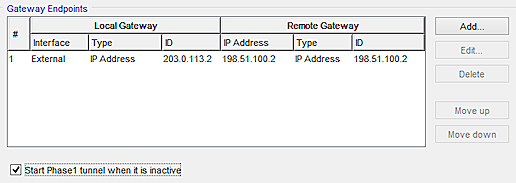
The configured gateway endpoint pair for the Site A primary BOVPN virtual interface in Policy Manager
The primary BOVPN virtual interface at Site A has one VPN route to the trusted network at Site B:
- Route to 10.50.1.0/24, Metric 1
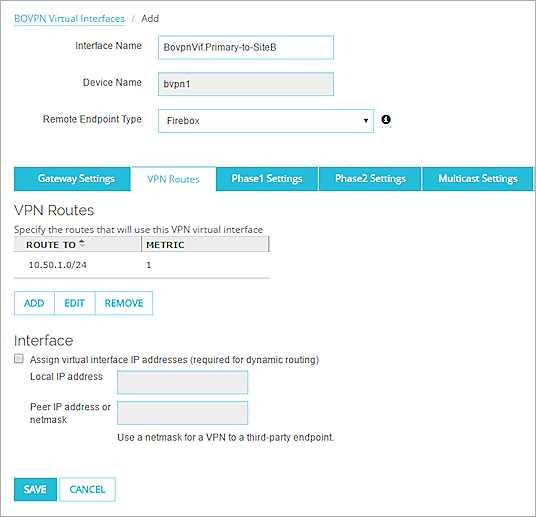
The configured VPN route for the Site A primary BOVPN virtual interface in Fireware Web UI
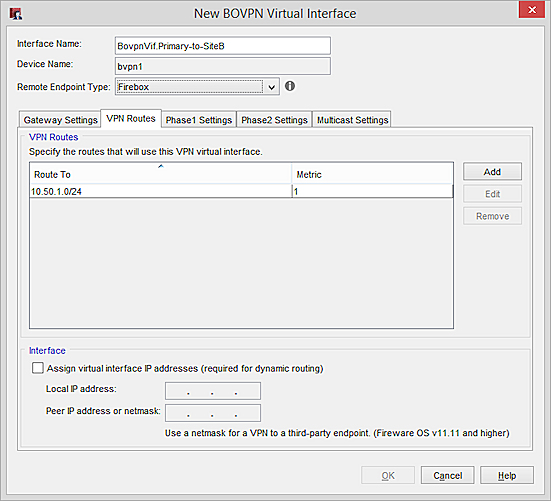
The configured VPN route for the Site A primary BOVPN virtual interface in Policy Manager
The secondary BOVPN virtual interface at Site A uses these gateway settings:
- In Fireware v11.12 or higher, a Remote Endpoint Type drop-down list appears that contains two options: Firebox, and Cloud VPN or Third-Party Gateway. To configure a tunnel between two Firebox devices, select the Firebox endpoint type, which uses the GRE protocol to encapsulate the IPSec tunnel.
- The Credential Method uses the pre-shared key the two sites agreed upon.
- The Gateway Endpoints list includes one gateway endpoint pair:
- External Interface: External-2
- Local Gateway: 190.0.2.2 (the IP address of the second external interface on the Site A Firebox)
- Remote Gateway: 198.51.100.2 (the IP address of the external interface on the Site B Firebox)

The configured gateway endpoint pair for the Site A secondary BOVPN virtual interface in Fireware Web UI

The configured gateway endpoint pair for the Site A secondary BOVPN virtual interface in Policy Manager
The secondary BOVPN virtual interface at Site A has one VPN route to the trusted network at Site B:
- Route to 10.50.1.0/24, Metric 200
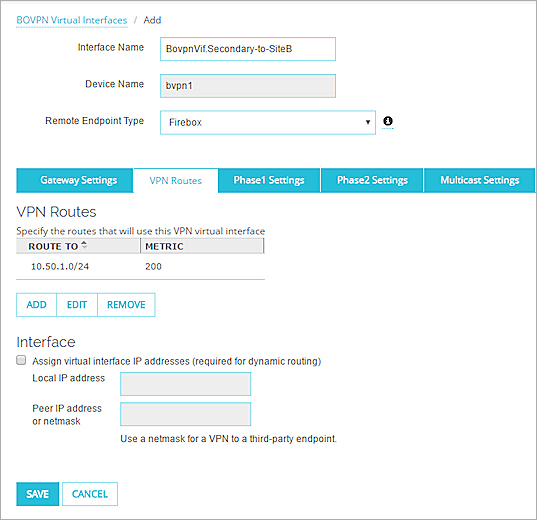
The configured VPN route for the Site A secondary BOVPN virtual interface in Fireware Web UI
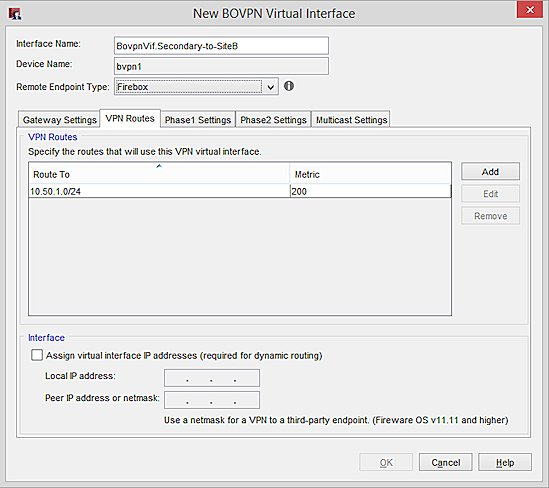
The configured VPN route for the Site A secondary BOVPN virtual interface in Policy Manager
Site B BOVPN Virtual Interfaces
The device at Site B has two BOVPN virtual interfaces.
The primary BOVPN virtual interface at Site B uses these gateway settings:
- In Fireware v11.12 or higher, a Remote Endpoint Type drop-down list appears that contains two options: Firebox, and Cloud VPN or Third-Party Gateway. To configure a tunnel between two Firebox devices, select the Firebox endpoint type, which uses the GRE protocol to encapsulate the IPSec tunnel.
- The Credential Method uses the pre-shared key the two sites agreed upon.
- The Gateway Endpoints list includes one gateway endpoint pair:
- Local Gateway: 198.51.100.2 (the IP address of the external interface on the Site B Firebox)
- Remote Gateway: 203.0.113.2 (the IP address of the first external interface on the Site A Firebox)

The gateway endpoint pair for the Site B primary BOVPN virtual interface in Fireware Web UI
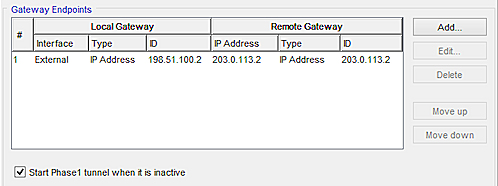
The gateway endpoint pair for the Site B primary BOVPN virtual interface in Policy Manager
The primary BOVPN virtual interface at Site B has two VPN routes to the trusted and optional networks at Site A:
- Route to 10.0.1.0/24, Metric 1
- Route to 10.0.2.0/24, Metric 1
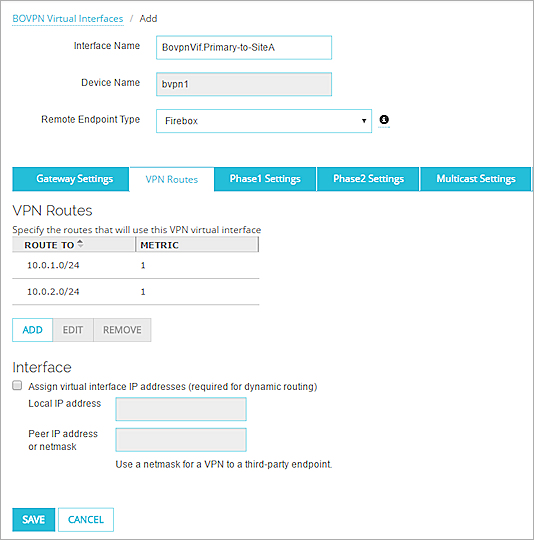
The configured VPN routes for the Site B primary BOVPN virtual interface in Fireware Web UI
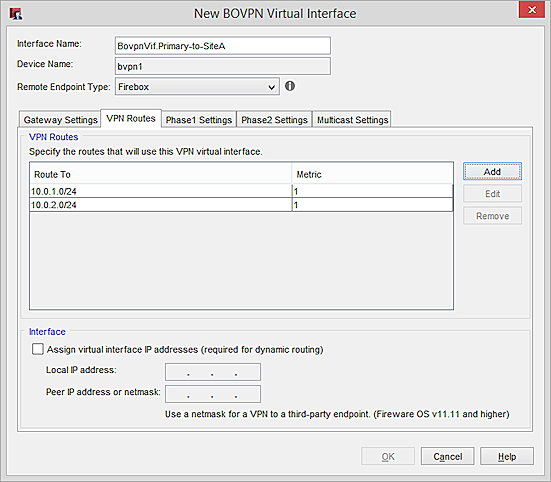
The configured VPN routes for the Site B primary BOVPN virtual interface in Policy Manager
The secondary BOVPN virtual interface at Site B, uses these gateway settings:
- In Fireware v11.12 or higher, a Remote Endpoint Type drop-down list appears that contains two options: Firebox, and Cloud VPN or Third-Party Gateway. To configure a tunnel between two Firebox devices, select the Firebox endpoint type, which uses the GRE protocol to encapsulate the IPSec tunnel.
- The Credential Method uses the pre-shared key the two sites agreed upon.
- The Gateway Endpoints list includes one gateway endpoint pair:
- Local Gateway: 198.51.100.2 (the IP address of the external interface on the Site B Firebox)
- Remote Gateway: 190.0.2.2 (the IP address of the second external interface on the Site A Firebox)

The configured gateway endpoint pair for the Site B secondary BOVPN virtual interface in Fireware Web UI
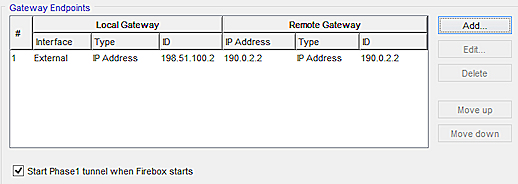
The configured gateway endpoint pair for the Site B secondary BOVPN virtual interface in Policy Manager
The secondary BOVPN virtual interface at Site B has two VPN routes to the trusted and optional networks at Site A:
- Route to 10.0.1.0/24, Metric 200
- Route to 10.0.2.0/24, Metric 200
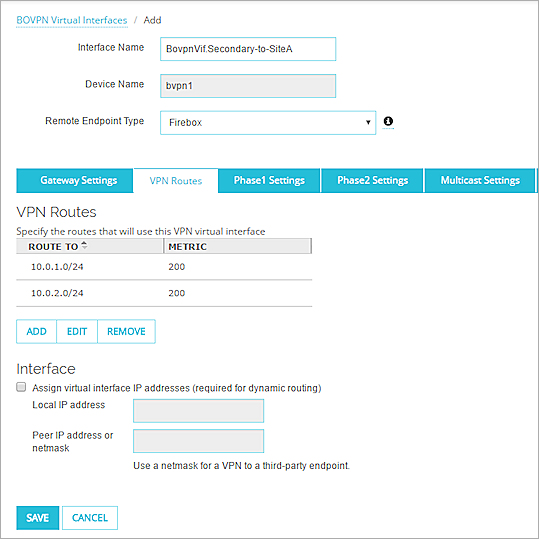
The configured VPN routes for the Site B secondary BOVPN virtual interface in Fireware Web UI
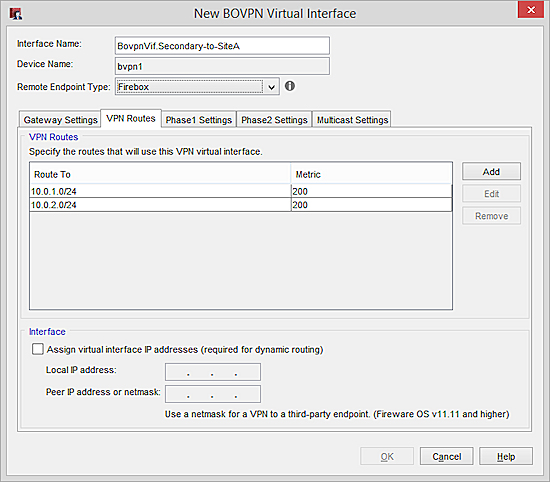
The configured VPN routes for the Site B secondary BOVPN virtual interface in Policy Manager.
How This Configuration Works
In this example, each Firebox has two BOVPN virtual interfaces to a peer Firebox. The routes configured for both BOVPN virtual interfaces are the same, except for the metrics. The Firebox uses the route with the lowest metric (highest priority). This means that:
If both BOVPN virtual interfaces are available
The Firebox uses the routes through the primary BOVPN virtual interface, because those routes have the highest priority (lowest metric).
If the primary BOVPN virtual interface is not available, but the secondary BOVPN virtual interface is available
The Firebox automatically changes the metrics for routes that use the primary BOVPN virtual interface to 255, to give these routes the lowest priority. The Firebox then uses the routes through the second BOVPN virtual interface, because those routes with a metric of 200 are now the highest priority routes to that destination.
When the primary BOVPN virtual interface becomes available again
The Firebox automatically changes the route metrics for routes through the primary BOVPN virtual interface back to the configured route metric, in this case 1. Traffic between the two sites automatically uses the routes through the primary BOVPN virtual interface because those routes now have higher priority.
You can optionally configure the Firebox to remove the route completely, rather than increase the metric when the route is down. For more information, see About Global VPN Settings.